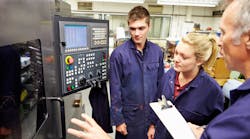When I first started my engineering career, I was thrown to the wolves—my college education didn’t prepare me for a real-life work environment. Now, usually when I touch on this in the context of Machine Design articles, some readers will fire back that it was up to me adapt to the work environment and that I lacked drive to educate myself. So to avoid confusion, let me clarify that my specific college education did not prepare me specifically for the job I was hired for.
What does that mean? I was unfamiliar with the how drawings were “specifically” done for my company, how paperwork was “specifically” handled, what engineering design methods were practiced “specifically” at my company, and even how to find engineering help. A simple example is when I first attempted to provide geometric, dimensioning, and tolerance (GD&T) to a drawing. I was taught to design for perfect conditions GD&T, with little to no tolerance.
Of course, in the real world, engineers provide tolerance to help the machinists making the part. These allowances vary from shop to shop and from company to company, with some having their own standard guidelines. Many large engineering companies do not properly train their new employees to unique “ins and outs” of their company, leaving young engineers to either sink or swim.
Our 2017 Salary and Career Report asked more than 2,000 engineers how the education of young talent should be handled. When asked if companies should provide more skill-level training to entry level engineers, 56% replied that companies should provide training for new hires. However, 93% noted that their company does not provide training to young engineers and 61% indicated that their companies do not have mentoring programs.
We often hear that many senior engineers complain about the lack of skills found in the young labor force. 42% of our readers agree that engineering students are not learning the appropriate skills and 87% believe that we are lacking a strong skilled labor force. When it comes to the argument of theoretical vs. practical knowledge learned in school, many agree that school is the place of theory and that the real world is the place for practical education.
But if that’s the case, how can we beat up on young engineers for not knowing practical skills the minute they exit college? If we want them to learn how to do things in a specific way (i.e., the exact method or modus operandi of a company) then that company should take the initiative in training them.
When our readers were asked what skills young engineers are bringing into their company, the responses were all in new and developing industry areas such as CAD/CAM and simulation (64%), 3D printing (31%), and robotics (24%). Clearly, there is value being brought in to these companies.
However, the missing component for many of these young engineers is how to take that theoretical knowledge and convert it into the appropriate practical format. Whether it is in a drawing, a white paper, a factory floor integration, or proper management of cost and materials, the method will be unique to whichever company they end up working for. This is where companies need to step up and teach young engineers “the company way” of executing the details.

